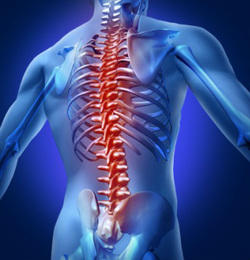 HERNIATED DISCS A common problem seen in chiropractic practice is pain, numbness, and/or weakness associated with a herniated disc. Though less commonly a cause of back or neck pain, herniated discs are among the most common causes of symptoms in the upper and lower extremities. Basic Anatomy The spine starts at the base of the skull and extends downward ending at the tailbone. It is comprised of 24 individual bones, called vertebrae. Each vertebra is separated from the ones above and below it by shock-absorbing structures called an intervertebral discs, or simply discs. Discs are made up of a tough, fibrous, outer shell (called the annulus) and a soft pulpy inner material (called the nucleus). In its normal, healthy state, the nucleus resides within the annulus like jelly inside of a doughnut. The discs help to absorb the shocks of jumping and running as well as the sustained weight-bearing loads born by the spine as a result of gravity. Approximately two thirds of our weight is supported by the discs, while one third is supported by the joints of the spine which sit behind the discs. Without the discs, all the weight of our bodies and the shock forces we experience during activities would be born by the joints of the spine alone, causing them to wear down quite quickly. Disc Herniation Herniated discs are very common findings seen on MRI or CT imaging. Herniated discs cannot be seen on X-rays. Herniation describes the abnormal protrusion of body material from an enclosed cavity. In the case of a disc herniation, the nucleus protrudes through the annulus, like jelly squeezing out of a doughnut. Weakened muscles of the ‘core’ in the lower back, abdomen, and buttocks lead to excessive weight bearing by the spine. This in turn places extra strain on the shock and weight absorbing discs. These excessive forces lead gradually over time to small tears in the tough, fibrous annulus. As these tears take place over time the areas containing tiny tears become structurally weakened, often leading to larger tears and extension of the damaged area to create a visible rent or defect in the annulus. When the tears are large enough, the gelatinous nuclear material migrates outward from the center to fill the rent, causing the disc to bulge. Disc bulges get bigger as the tearing continues over time until finally, the annulus tears open completely (ruptures), creating an opening large enough to allow some of the nuclear material to protrude from the disc out into what is called the spinal canal and/or the lateral recesses. At this point, we refer to the process as a disc protrusion or a herniated disc. Perhaps the most important thing to understand right from the start is that annular tearing, disc bulges, and even disc protrusions/herniations are not necessarily painful events. Discs themselves have generally poor nerve supply and in many patients disc injuries are not associated with any pain. It is rare that chronic back or neck pain comes from a herniated disc. That is not to say that disc herniations cannot cause pain into an extremity (arm or leg), or that the swelling and inflammation associated with large, sudden disc herniations cannot cause acute pain in the back or neck. But approximately 50% of all adults who have never experienced significant pain in the neck or back have disc herniations on MRI evaluation. This means that somewhere along the way, the progression of tearing, bulging and ultimately herniation took place with no symptoms whatsoever. So common is the finding of a herniated disc, that clinicians skilled in treating neck and back pain must have much more evidence than simply the finding of a disc protrusion on a CT or MRI scan before making a diagnosis. A finding is something that is abnormal on an examination. A diagnosis is a disease or disorder. When a finding is the cause of a condition, it is sometimes used as a diagnosis. However, in the case of disc herniation, the finding is often not the cause of the problem. If your condition has been attributed to a herniated, degenerated, or bulging disc, you should be sure that your clinician has been careful to match your findings to your symptoms and to rule out all the other more common causes for your problem.
0 Comments
Leave a Reply. |
AuthorArchives
August 2021
Categories
All
|


 RSS Feed
RSS Feed